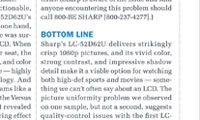Anatomy of an HDTV Test Report Page 4
 BOTTOM LINE By the time you get to the Bottom Line - after you've pored over the minutiae in the Test Bench box (detailed next) - you can look forward to reading a summary of both the good and the not-so-good points of the TV's features and performance. This is also where we pass judgment on how the set racks up value-wise against its immediate competition. You'll probably want to know if the TV gets an S&V recommendation. If that subject isn't addressed in the Bottom Line, a Certified and Recommended stamp on the first page of the review will clearly indicate an emphatic thumbs-up.
BOTTOM LINE By the time you get to the Bottom Line - after you've pored over the minutiae in the Test Bench box (detailed next) - you can look forward to reading a summary of both the good and the not-so-good points of the TV's features and performance. This is also where we pass judgment on how the set racks up value-wise against its immediate competition. You'll probably want to know if the TV gets an S&V recommendation. If that subject isn't addressed in the Bottom Line, a Certified and Recommended stamp on the first page of the review will clearly indicate an emphatic thumbs-up.
TEST BENCH Our Test Bench box on the second page of the review contains a condensed version of the full lab report, which can be found in the Equipment section of our Web site. The provided chart is used mainly to illustrate the set's level of deviation from the 6,500-K standard - something known as Grayscale Tracking - both before and after any special adjustments performed during the evaluation. Of course, we'll also make a point of letting you know here how the set's post-adjustment tracking numbers measure up to those of an average TV of its type.
Other lab tests summarized in the "Test Bench" include Color Point Accuracy, Color Decoder Error, Overscan, Resolution, Uniformity, and Video Processing.
Color Point Accuracy indicates the TV's level of adherence to the SMPTE (Society for Motion Picture and Television Engineers) specification for high-definition red, green, and blue. Though it's not uncommon for a set to show some oversaturation on one or more of its color points, the closer it adheres to the spec, the better. Meanwhile, tests for Color Decoder Error show the TV's ability to accurately translate encoded color information from standard- and high-def sources (each format gets handled differently) for display on the set's screen. A 5% positive or negative red or green shift falls in the average range here, while numbers greater than that could indicate potentially image-degrading effects. Along with grayscale tracking, which is normally easy for a certified technician to adjust using specialized test equipment, both color-point accuracy and color-decoder error can potentially be improved by professional calibration.
- Log in or register to post comments





























































